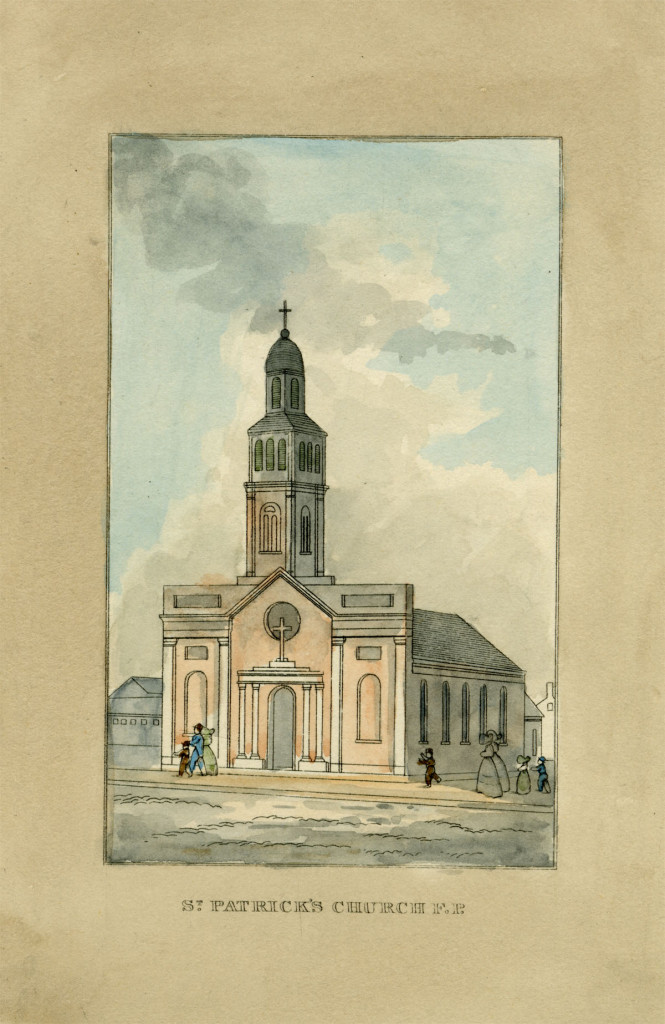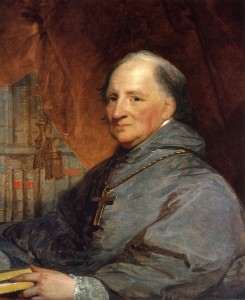
On March 17, 1814, Catholic parishioners in Fell’s Point gathered at St. Patrick’s Church in Fell’s Point to participate in a “Divine Service” led by the Archbishop of Baltimore John Carroll and Reverend Benedict Joseph Fenwick.

Archbishop Carroll (whose father Daniel Carroll had been born in Ireland) supported the St. Patrick’s Church and the city’s growing Irish Catholic community since the southeast Baltimore congregation was established in 1791. St. Patrick’s Day celebrations in the United States date to the 1760s (or earlier) and, in Baltimore, celebrations are documented as early as 1795. One account published on March 19, 1803 in the American Patriot offers a picture of the “festivity and merriment”:
“The 17th inst has been celebrated according to ancient custom, with great festivity and merriment by the sons of St. Patrick in this city. Though the Irish harp has been for some time unstrung, yet there was no lack of pipers, fiddlers and flutes on Patrick’s Day in the morning. A band of patriotic and excellent musicians paraded the principal streets, and complimented several gentlemen with airs most grateful to those who are always alive to Eire go Brath.
In the evening there was a subscription ball given at the Columbian Inn (West Baltimore Street), by some of the most respectable Irish characters in the city, when the ladies of Hibernia had an opportunity of displaying their agility and native charms.”
In August 1803, a group of Irish immigrants and descendants met at the Fountain Inn (then under the management of James Bryden). On August 15, 1803, the Baltimore Federal Gazette published the announcement that set out the purpose for the new group:
“Emigrants are arriving from Ireland; many of them are in a friendless and forlorn condition, deprived of health and an asylum. They have a claim upon those that have preceded them, to whom industry has proved propitious. There are many, very many of our inhabitants who feel all the influence of compassion, and who impatiently wait to be informed how they may make themselves useful to unprotected adventurers. A meeting of those who are so disposed, whether foreigners or native, is requested to morrow evening at four o’clock at Mr. Bryden’s tavern, Laight Street in order to devise a plan by which their benevolent design may be carried into execution.”
Their efforts at the Fountain Inn on Light Street soon led to the formation of the Hibernian Society of Baltimore: an Irish civic organization that continues to organize annual St. Patrick’s Day banquets and celebrations up to today.
We found no account of the Hiberian Society banquet or other 1814 celebrations beyond the morning service (historian John Daniel Crimmins speculated that the blockade of Baltimore “temporarily interrupted the Hiberian Society’s functions”) but an 1813 account of an evening dinner (published in the American on March 20, 1813) opens a window on the how the War of 1812 affected the mood of the feast day.
On March 17, 1813, a “select company of the Sons of Erin” meeting at Mr. Neale Nugent’s Tavern where they enjoyed a “sumptous dinner served up in a style of elegance” and made a series of toasts reflecting the pride of these Irish Americans in Baltimore:
The friends of reform in Ireland—May success crown their efforts—May the happiness of emancipated millions be the result of their patriotic labors.
The United States—The land of our adoption the only free country on the globe. While English drums rattle at our doors, may every friend of freedom know his place…
Our short history of St. Patrick’s Day in Baltimore 1814 is largely based on the Baltimore chapter of the 1902 history, St. Patrick’s Day: It’s Celebration in New York and Other American Places by John Daniel Crimmins. Enjoy the full chapter on Google Books for more details on St. Patrick’s Day and early Irish history in Baltimore.